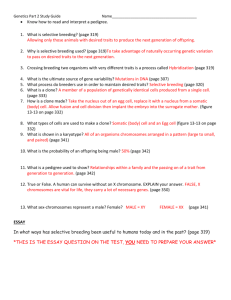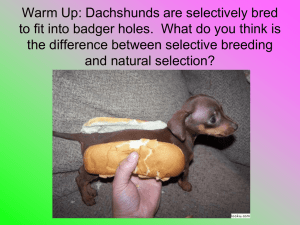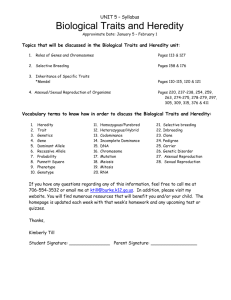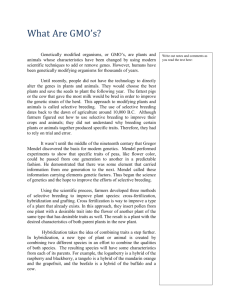Genetics DBQ - Cobb Learning
advertisement
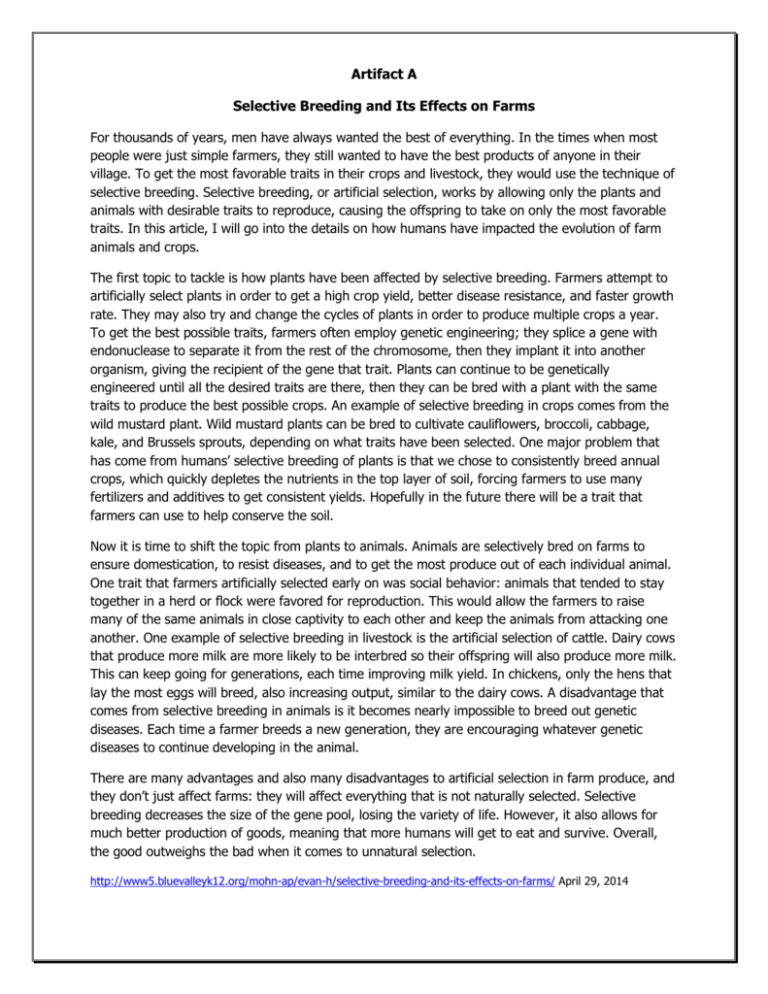
Artifact A Selective Breeding and Its Effects on Farms For thousands of years, men have always wanted the best of everything. In the times when most people were just simple farmers, they still wanted to have the best products of anyone in their village. To get the most favorable traits in their crops and livestock, they would use the technique of selective breeding. Selective breeding, or artificial selection, works by allowing only the plants and animals with desirable traits to reproduce, causing the offspring to take on only the most favorable traits. In this article, I will go into the details on how humans have impacted the evolution of farm animals and crops. The first topic to tackle is how plants have been affected by selective breeding. Farmers attempt to artificially select plants in order to get a high crop yield, better disease resistance, and faster growth rate. They may also try and change the cycles of plants in order to produce multiple crops a year. To get the best possible traits, farmers often employ genetic engineering; they splice a gene with endonuclease to separate it from the rest of the chromosome, then they implant it into another organism, giving the recipient of the gene that trait. Plants can continue to be genetically engineered until all the desired traits are there, then they can be bred with a plant with the same traits to produce the best possible crops. An example of selective breeding in crops comes from the wild mustard plant. Wild mustard plants can be bred to cultivate cauliflowers, broccoli, cabbage, kale, and Brussels sprouts, depending on what traits have been selected. One major problem that has come from humans’ selective breeding of plants is that we chose to consistently breed annual crops, which quickly depletes the nutrients in the top layer of soil, forcing farmers to use many fertilizers and additives to get consistent yields. Hopefully in the future there will be a trait that farmers can use to help conserve the soil. Now it is time to shift the topic from plants to animals. Animals are selectively bred on farms to ensure domestication, to resist diseases, and to get the most produce out of each individual animal. One trait that farmers artificially selected early on was social behavior: animals that tended to stay together in a herd or flock were favored for reproduction. This would allow the farmers to raise many of the same animals in close captivity to each other and keep the animals from attacking one another. One example of selective breeding in livestock is the artificial selection of cattle. Dairy cows that produce more milk are more likely to be interbred so their offspring will also produce more milk. This can keep going for generations, each time improving milk yield. In chickens, only the hens that lay the most eggs will breed, also increasing output, similar to the dairy cows. A disadvantage that comes from selective breeding in animals is it becomes nearly impossible to breed out genetic diseases. Each time a farmer breeds a new generation, they are encouraging whatever genetic diseases to continue developing in the animal. There are many advantages and also many disadvantages to artificial selection in farm produce, and they don’t just affect farms: they will affect everything that is not naturally selected. Selective breeding decreases the size of the gene pool, losing the variety of life. However, it also allows for much better production of goods, meaning that more humans will get to eat and survive. Overall, the good outweighs the bad when it comes to unnatural selection. http://www5.bluevalleyk12.org/mohn-ap/evan-h/selective-breeding-and-its-effects-on-farms/ April 29, 2014 Artifact B Heredity and Genes Heredity is the passing on of characteristics from one generation to the next. It is the reason why offspring look like their parents. It also explains why cats always give birth to kittens and never puppies. The process of heredity occurs among all living things including animals, plants, bacteria, protists and fungi. The study of heredity is called genetics and scientists that study heredity are called geneticists. Through heredity, living things inherit traits from their parents. Traits are physical characteristics. You resemble your parents because you inherited your hair and skin color, nose shape, height, and other traits from them. Cells are the basic unit of structure and function of all living things. Tiny biochemical structures inside each cell called genes carry traits from one generation to the next. Genes are made of DNA, and different patterns of A, T, G, and C code for the instructions for making things your body needs to function (like the enzymes to digest food or the pigment that gives your eyes their color). As your cells duplicate, they pass this genetic information to the new cells. Genes are strung together to form long chains of DNA in structures known as chromosomes. Genes are like blueprints for building a house, except that they carry the plans for building cells, tissues, organs, and bodies. They have the instructions for making the thousands of chemical building blocks in the body. These building blocks are called proteins. Proteins are made of smaller units called amino acids. Differences in genes cause the building of different amino acids and proteins. Genes are found on chromosomes and determine specific human characteristics, such as height or hair color. Because you have a pair of each chromosome, you have two copies of every gene (except for some of the genes on the X and Y chromosomes in boys, because boys have only one of each). Most cells in the human body have 23 pairs of chromosomes, making a total of 46. Individual sperm and egg cells, however, have just 23 unpaired chromosomes. You received half of your chromosomes from your mother's egg and the other half from your father's sperm cell. A male child receives an X chromosome from his mother and a Y chromosome from his father; females get an X chromosome from each parent. Some characteristics come from a single gene, whereas others come from gene combinations. Because every person has about 25,000 different genes, there is an almost endless number of possible combinations! A gene gives only the potential for the development of a trait. How this potential is achieved depends partly on the interaction of the gene with other genes. But it also depends partly on the environment. http://www.cccoe.net/genetics/heredity.html Artifact C Selective Breeding Selective breeding is the traditional method for improving crops and livestock, such as increasing disease resistance or milk yield. Genetic engineering is a faster way, which transplants genes for a desired characteristic into an organism. However, genetic engineering offers many potential benefits but carries the risk of unexpected harmful effects. Selective breeding and genetic engineering Over the centuries humans have tried to breed better crops and livestock. Traditionally this was done by carefully choosing parents for breeding that show the required characteristics selective breeding. More recently it's been possible to implant particular genes using genetic engineering. Both these techniques depend on there being change and variation in the genetic material – which is caused by mutations. Mutation Mutation means any change in the genetic material. Mutation occurs naturally. Most mutations are harmful to an individual, but occasionally a mutation can be beneficial. It's possible to speed up mutation rates artificially using radiation or chemicals. Mutations bring about changes in organisms by changing the sequence of bases in DNA. This causes a different protein to be made, or blocks the production of the protein completely. Selective breeding These are the steps in selective breeding: 1. Decide which characteristics are important 2. Choose parents that show these characteristics 3. Select the best offspring from parents to breed the next generation 4. Repeat the process continuously Examples of selective breeding Wheat - Producing disease-resistant wheat by crossbreeding wheat plants with disease resistance and wheat plants with a high yield. Dairy cattle - Increasing milk yield by selecting bulls from high yield herds and breeding them with cows that have the best milk production. Cattle breeds - Selective breeding can also be used to modify other characteristics of cattle. Problems with selective breeding - higher tier Future generations of selectively bred organisms will all share very similar genes. This could make some diseases more dangerous as all the organisms would be affected. Also there's increased risk of genetic disease caused by recessive genes. Some genes would be lost, making it more difficult to produce new varieties in the future. In scientific language this would be described as ‘inbreeding can lead to a reduction in the size of the gene pool’. Genetic engineering A faster way of producing new varieties is to transfer the genes for the desired characteristic into an organism artificially. This is genetic engineering. The gene may have come from the same species, but genetic engineering also allows the genes from an unrelated organism to be transferred – something that's not possible with selective breeding. Genetic engineering can be used to create new varieties of plant and animal, but there's a risk that there could be unexpected harmful effects, either to the new organism or if the gene “escapes” into the surrounding populations. Some people are concerned about the health risk of eating genetically modified food – others think it wrong to create new life forms, or move genes between different species, especially if this causes harm to the receiver. http://www.bbc.co.uk/schools/gcsebitesize/science/add_gateway_pre_2011/living/genesrev1.sh tml Artifact D Biotechnology James Watson and the late Francis Crick with a DNA helix model James Watson and the late Francis Crick discovered the structure of DNA in 1953; Watson has spoken in favor of genetic engineering. Biotechnology isn't something new - selective breeding to create more useful varieties of animals and plants is a form of biotechnology that human beings have used for thousands of years. Biotechnology may include any use of science or technology to alter the characteristics of a particular breed or animal. Biotechnology can be good or bad for animals - and it may also produce an answer to the ethical problems of experimenting on animals. Human problems Newspaper articles about the ethical problems of genetically engineered animals are usually concerned about the danger these animals may pose to human beings (usually to human health), rather than any implications for the animals themselves. Animal rights Genetic engineering and selective breeding appear to violate animal rights, because they involve manipulating animals for human ends as if the animals were nothing more than human property, rather than treating the animals as being of value in themselves. Recent action to allow animals to be patented reinforces the idea of animals as human property, rather than beings in their own right. Animal welfare Biotechnology can be good for animals. Selective breeding and genetic engineering can benefit animals in many ways: Improving resistance to disease Breeding to remove characteristics that cause injury – Ex. selecting cattle without horns But biotechnology can also be bad for animals - the good effects for the breeder can offset by painful side-effects for the animals: Modern pigs have been bred to grow extra fast - some breeds now grow too fast for their hearts, causing discomfort when animals are too active Broiler chickens are bred to grow fast - some now grow too fast for their legs Regulating genetic engineering Profitability is one of the major drivers of both selective breeding and genetic engineering. If animal welfare is not to be compromised, research must be restricted by a counter-balancing ethical principle that prevents altering animals in a way that was bad for the animal. http://www.bbc.co.uk/schools/gcsebitesize/science/add_gateway_pre_2011/living/genesrev3.shtml Artifact E Artifact F Artifact F Essay Questions: How do genes influence traits? What is selective breeding and how is it beneficial? Would you argue in favor of or against genetically designing babies and genetically enhancing human beings? Original concept found on TPT and produced by JCB Education Services 2013. Modified 3/2015



